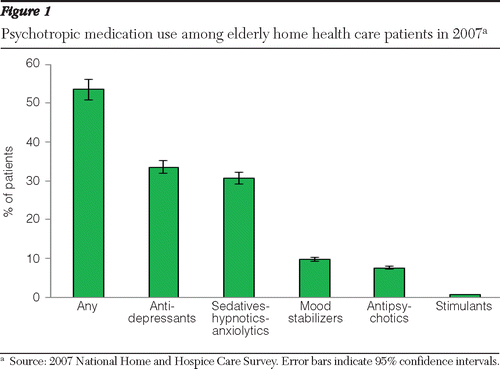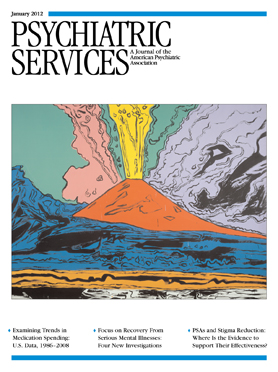Datapoints: Psychotropic Drug Use Among Elderly Patients in Home Care in the United States
An estimated 1.5 million persons in the United States receive home-based care involving a range of therapeutic and medical services (1). Most patients who receive home-based health care are elderly, with various levels of functional impairment. Although psychotropic medications are extensively used in the elderly population, limited data exist on the psychotropic needs of elderly home health patients.
Psychotropic medication use was examined among elderly home health care patients age 65 and older by using the 2007 National Home and Hospice Care Survey (NHHCS), a national survey of U.S. home health and hospice agencies (2). Patient data for the NHHCS were obtained from interviews with designated agency staff members, who provided information from medical and medication administration records. Descriptive statistics, including 95% confidence intervals (CIs), were used to examine prevalence patterns of psychotropic drug use.
More than a half million of the elderly home health care patients received at least one psychotropic agent—.54 million patients (CI=.50–.58) or 53.52% of the elderly patients (CI=50.60–56.44). As shown in Figure 1, antidepressants were the most frequently prescribed psychotropic agents (33.51%, CI=30.71–36.31), followed by sedatives-hypnotics-anxiolytics (30.65%, CI=27.96–33.34), mood stabilizers (9.87%, CI=8.15–11.59), and antipsychotics (7.55%, CI=6.08–9.03). Selective serotonin reuptake inhibitors (SSRIs) were the most frequently prescribed antidepressants (21.83%, CI=19.39–24.28), and benzodiazepines constituted a majority of the sedatives-hypnotics-anxiolytics prescribed (21.30%, CI=18.93–23.68).
This study found that the overall prevalence of psychotropic use among elderly home health care patients was 54%, nearly 10 percentage points less than psychotropic use in nursing homes (63%) (3). The high prevalence of psychotropic use among home health care patients was mainly driven by the use of SSRIs and benzodiazepines. Given the inappropriate use of psychotropic agents among elderly patients and the poor health status of those receiving home health care, there is a need to monitor use of psychotropic drugs in this vulnerable population.
1 : Home Health Care and Discharged Hospice Care Patients: United States, 2000 and 2007. National Health Statistics Reports, 38. Hyattsville, Md, National Center for Health Statistics, 2011 Google Scholar
2 2007 National Home and Hospice Care Survey and National Home Health Aide Survey. Atlanta, Ga, Centers for Disease Control and Prevention, 2007. Available at www.cdc.gov/nchs/data/nhhcsd/NHHCS_NHHAS_web_documentation.pdf Google Scholar
3 : Psychotropic drug utilization among elderly nursing home residents in the United States. Psychiatric Services 61:655, 2010 Link, Google Scholar
Figures and Tables

Figure 1 Psychotropic medication use among elderly home health care patients in 2007



